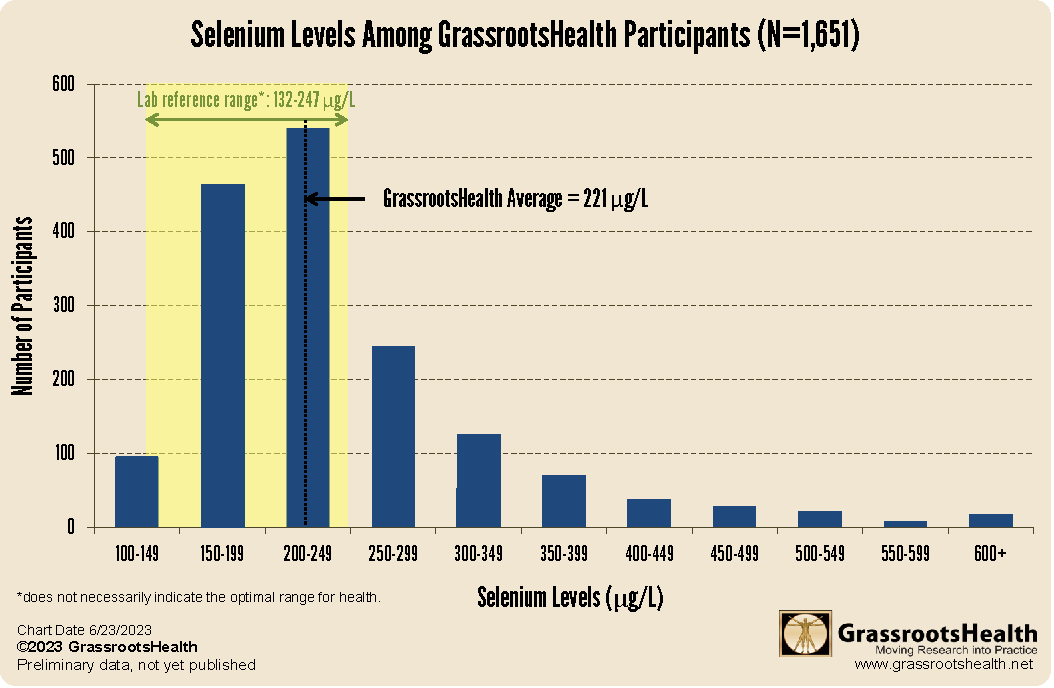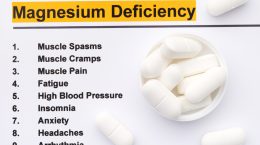Published on July 10, 2023
The average GrassrootsHealth participant has a selenium level in the higher end of the lab reference range – where is your selenium level compared to others?
Key Points
- Selenium is an essential nutrient with antioxidant properties that plays a key role in thyroid function, reproduction, immune health, and DNA synthesis, and it influences the production of cytokines and eicosanoids — chemical messengers that regulate inflammation and immune cell function
- Among the 1,651 participants who tested their selenium levels, the average level of their latest test was 221 μg/L which falls within the lab reference range (132-247 μg/L); this reference range only indicates the range of typical results found in the population the lab serves but does not necessarily indicate the optimal range for health
- The only way to know your level is to test! Thank you to all of our participants who have measured their selenium levels as part of the Elements Panel in the D*action project.
 Selenium is an essential nutrient with antioxidant properties that plays a key role in thyroid function, reproduction, immune health, and DNA synthesis. Selenium also influences the production of cytokines and eicosanoids — chemical messengers that regulate inflammation and immune cell function. Studies have found an association between higher selenium status and a lower risk of cancer (including breast cancer), cognitive decline, cardiovascular disease, and COVID-19.
Selenium is an essential nutrient with antioxidant properties that plays a key role in thyroid function, reproduction, immune health, and DNA synthesis. Selenium also influences the production of cytokines and eicosanoids — chemical messengers that regulate inflammation and immune cell function. Studies have found an association between higher selenium status and a lower risk of cancer (including breast cancer), cognitive decline, cardiovascular disease, and COVID-19.
The optimal therapeutic range for selenium is narrow, and excess selenium can become toxic. A severe deficiency of selenium may lead to impairment of anti-oxidant actions and thyroid functions, whereas an excess of selenium may lead to death.
Selenium Levels among GrassrootsHealth Participants
In the spring of 2019, GrassrootsHealth started offering a selenium test as part of the Elements Panel, which includes testing your vitamin D level along with essential elements magnesium, zinc, copper, and copper:zinc ratio, and toxic heavy metals cadmium, lead, and mercury. This test reflects both free selenium in the blood and selenium as a component of selenoproteins (proteins containing selenium). Since heavy metals (especially mercury) bind to selenium and reduce its bioavailability, this dried blood spot test is particularly useful for determining if enough selenium is present to counteract these heavy metals in the body.
Among the 1,651 participants who tested their selenium levels, the average level of their latest test was 221 μg/L which falls within the lab reference range (132-247 μg/L); this reference range only indicates the range of typical results found in the population the lab serves but does not necessarily indicate the optimal range for health. The chart below illustrates the levels of selenium among GrassrootsHealth participants.
While higher selenium status has been associated with reduced disease risk, the optimal range for health is not known. Excess selenium can cause nausea, diarrhea, neurological symptoms, and heart problems so it’s important to identify this optimal range. Your ongoing participation in this project will contribute greatly to knowing what levels are optimal for health. We will continue to track this data and report any results back to you.
Thanks to all who are participating!
What is Your Selenium Level Compared to the GrassrootsHealth Cohort?
The only way to know is to test your levels! Selenium, along with vitamin D, magnesium, zinc, and omega-3s, are just a few nutrients vital to maintaining many aspects of our health. To know if you are getting enough, make sure you test today!
Testing versus blind supplementation is essential to know for sure if what you are taking is the right amount for you. Once you test your vitamin D (and other levels) to know where you are NOW, you can account for any upcoming changes in lifestyle over the coming months and adjust your intake to reach (or maintain) your targets.
- Vitamin D
- Magnesium PLUS Elements
- Omega-3 Fatty Acids
- hsCRP
- HbA1c
- TSH
- Type 1 Diabetes Autoantibodies
Did you know that each of the above can be measured at home using a simple blood spot test? As part of our ongoing research project, you can order your home blood spot test kit to get your levels, followed by education and steps to take to help you reach your optimal target levels. Start by enrolling and ordering your kit to measure each of the above important markers, and make sure you are getting enough of each to support better mood and wellbeing!
Create your custom home test kit today. Take steps to improve the status of each of these measurements to benefit your overall health. With measurement you can then determine how much is needed and steps to achieve your goals. You can also track your own intakes, symptoms and results to see what works best for YOU.
Enroll in D*action and Test Your Levels Today!
How can I track my nutrient intake and levels over time?
To help you track your supplement use and nutrient levels, GrassrootsHealth has created the Personal Health Nutrient Decision System called

For each specific supplement, you can track what days you take it, how much, and many other details. This will help you know your true supplemental intake and what patterns of use work for you to reach and maintain optimum nutrient levels. Check it out today!






